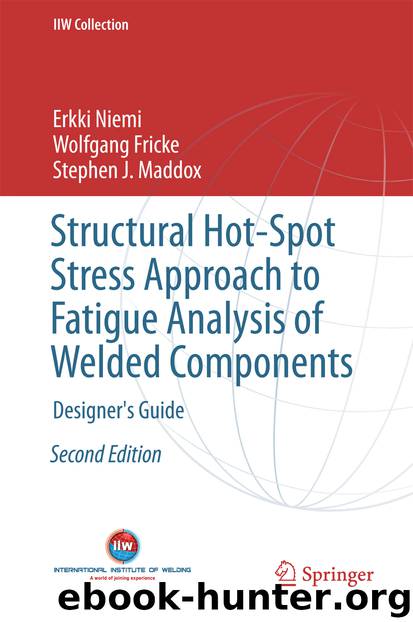Structural Hot-Spot Stress Approach to Fatigue Analysis of Welded Components by Erkki Niemi Wolfgang Fricke & Stephen J. Maddox

Author:Erkki Niemi, Wolfgang Fricke & Stephen J. Maddox
Language: eng
Format: epub
Publisher: Springer Singapore, Singapore
4.5 Use of Relatively Fine Element Meshes
Use of a relatively fine element mesh is recommended for the following:in complex details and details showing a high stress gradient close to the hot-spot;
when evaluating the structural hot-spot stress by through-thickness linearization or at a single point close to the hot-spot (surface stress extrapolation is possible as well);
when comparing FEA results and measured stresses.
4.5.1 Solid Element Modelling
Solid element modelling allows the weld geometry to be considered, as illustrated in Fig. 4.2. Since the extrapolation method uses nodal stresses 0.4t and 1.0t from the weld toe when applied to Type “a” hot spots, the first element length should be no more than 0.4t and the second element length no more than 0.6t in the loading direction, Fig. 4.6. For Type “b” hot spots, the required maximum element sizes are shown in Fig. 4.3c. Also the element width should be smaller than in coarse models, see Table 4.1. If a refined mesh is used, it is generally recommended to subdivide the mesh shown in Fig. 4.3(a, c) in both directions, i.e. in the direction of stress extrapolation as well as in the thickness direction.
Fig. 4.6An example of simple solid element modelling of a bracket welded on a plate. The darkest face is a symmetry plane
Download
This site does not store any files on its server. We only index and link to content provided by other sites. Please contact the content providers to delete copyright contents if any and email us, we'll remove relevant links or contents immediately.
Whiskies Galore by Ian Buxton(41711)
Introduction to Aircraft Design (Cambridge Aerospace Series) by John P. Fielding(33011)
Small Unmanned Fixed-wing Aircraft Design by Andrew J. Keane Andras Sobester James P. Scanlan & András Sóbester & James P. Scanlan(32678)
Craft Beer for the Homebrewer by Michael Agnew(18074)
Turbulence by E. J. Noyes(7888)
The Complete Stick Figure Physics Tutorials by Allen Sarah(7258)
Kaplan MCAT General Chemistry Review by Kaplan(6812)
The Thirst by Nesbo Jo(6748)
Bad Blood by John Carreyrou(6468)
Modelling of Convective Heat and Mass Transfer in Rotating Flows by Igor V. Shevchuk(6349)
Learning SQL by Alan Beaulieu(6152)
Weapons of Math Destruction by Cathy O'Neil(6075)
Man-made Catastrophes and Risk Information Concealment by Dmitry Chernov & Didier Sornette(5870)
Digital Minimalism by Cal Newport;(5576)
Life 3.0: Being Human in the Age of Artificial Intelligence by Tegmark Max(5396)
iGen by Jean M. Twenge(5294)
Secrets of Antigravity Propulsion: Tesla, UFOs, and Classified Aerospace Technology by Ph.D. Paul A. Laviolette(5232)
Design of Trajectory Optimization Approach for Space Maneuver Vehicle Skip Entry Problems by Runqi Chai & Al Savvaris & Antonios Tsourdos & Senchun Chai(4949)
Electronic Devices & Circuits by Jacob Millman & Christos C. Halkias(4859)
